Instruction
How “long arms” at the top of the backswing can help you hit the ball farther
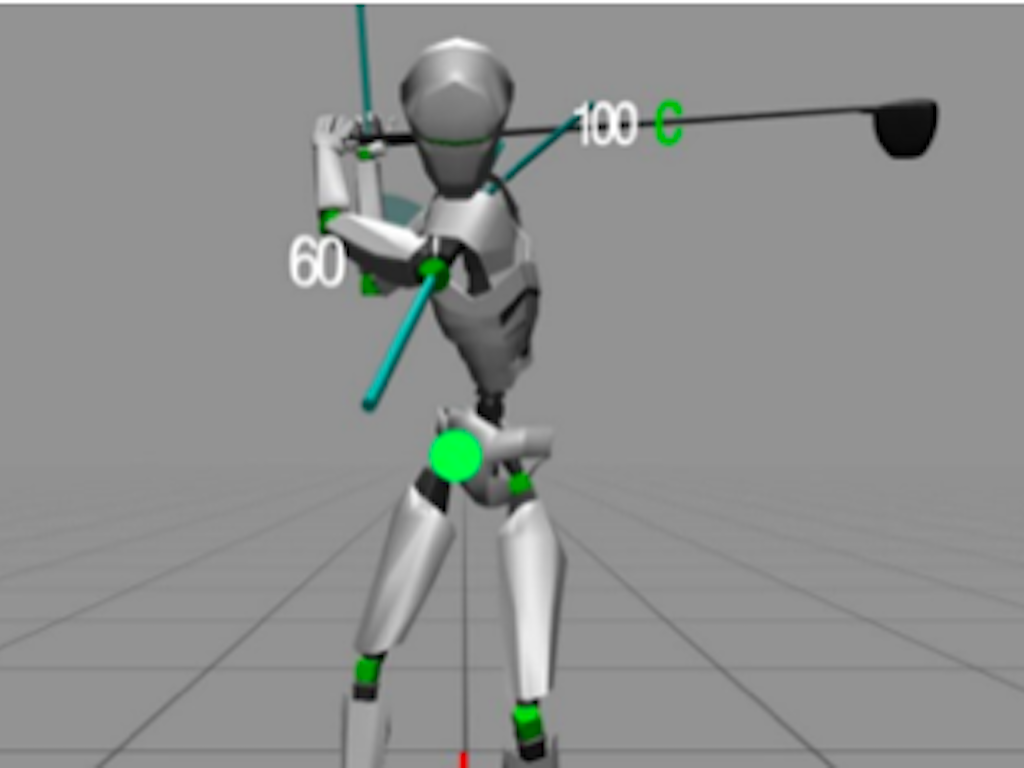
One of the hardest things to do as we get older is to make a big shoulder turn with extended arms at the top. It’s the swing of a younger golfer! However, every one of us can add width at the top so we can hit it farther, but few know how to actually do so. In this article, I will use MySwing 3D Motion Analysis to help you understand how beneficial long arms are at the top.
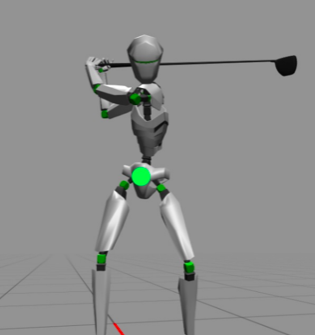
As you examine the swing of this particular player, you will notice that the lead arm is “soft” and the hands are close to this player’s head at the top. This is the classic narrow armswing to the top that most older players employ. And as we all know this position leaves yardage in the bag!
Now let’s look at the data so we can see what is actually happening…
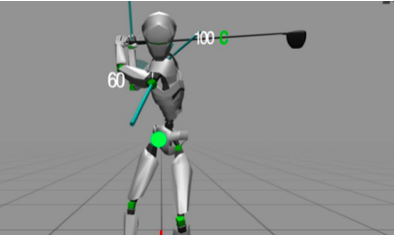
At the top you can see that the shoulders have turned 100 degrees which is more than enough, but the arms look jammed and narrow at the top. Why?
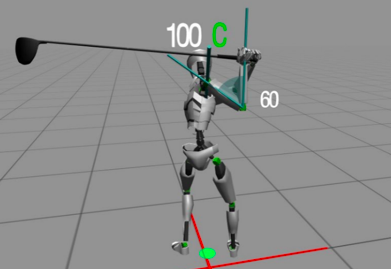
The answer lies within the actions of the rear arm, the lead arm is only REACTING to the over-bending of the rear elbow. As you can see at the top the rear elbow is bent 60 degrees. In a perfect world, when the rear elbow is at 90 degrees (a right angle) or more, the lead arm will be mostly straight — depending on how you’re built.
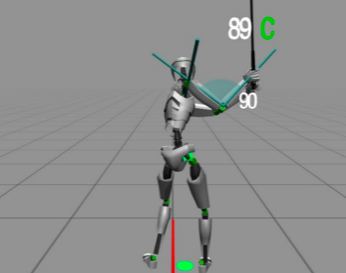
Something to note…in this position the hands are just past the chest and the shoulders have turned almost 90 degrees. However, when this player finished his backswing, he added 30 more degrees of rear elbow bend and only 11 more degrees of shoulder turn! What this means is that for the last quarter of the backswing, all this player did is allow the hands to basically collapse to the top of the backswing. This move is less than efficient and will cause major issues in your downswing sequencing, as well as, your transitional action.

As stated when your trail elbow stays at 90 degrees or wider in route to the top, you will have a much straighter lead arm.
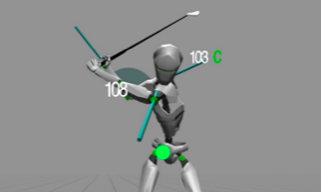
One last thing to note when comparing these two players is that this player two had a shorter backswing length but a BIGGER shoulder turn with WIDER arms at the top, giving this player a short compact motion that resembles Adam Scott — which seems to work for he and Butch!
Therefore, the thing to remember is that if your lead arm is soft at the top and your arms look crowded at the top, then you must fix the over-bending of the rear elbow on the backswing. And if you have wider arms you will have a more solid “package” to become a ballstriking machine!
- LIKE139
- LEGIT12
- WOW3
- LOL1
- IDHT0
- FLOP5
- OB5
- SHANK21
Instruction
The Wedge Guy: The easiest-to-learn golf basic

My golf learning began with this simple fact – if you don’t have a fundamentally sound hold on the golf club, it is practically impossible for your body to execute a fundamentally sound golf swing. I’m still a big believer that the golf swing is much easier to execute if you begin with the proper hold on the club.
As you might imagine, I come into contact with hundreds of golfers of all skill levels. And it is very rare to see a good player with a bad hold on the golf club. There are some exceptions, for sure, but they are very few and very far between, and they typically have beat so many balls with their poor grip that they’ve found a way to work around it.
The reality of biophysics is that the body moves only in certain ways – and the particulars of the way you hold the golf club can totally prevent a sound swing motion that allows the club to release properly through the impact zone. The wonderful thing is that anyone can learn how to put a fundamentally sound hold on the golf club, and you can practice it anywhere your hands are not otherwise engaged, like watching TV or just sitting and relaxing.
Whether you prefer an overlap, interlock or full-finger (not baseball!) grip on the club, the same fundamentals apply. Here are the major grip faults I see most often, in the order of the frequency:
Mis-aligned hands
By this I mean that the palms of the two hands are not parallel to each other. Too many golfers have a weak left hand and strong right, or vice versa. The easiest way to learn how to hold the club with your palms aligned properly is to grip a plain wooden ruler or yardstick. It forces the hands to align properly and shows you how that feels. If you grip and re-grip a yardstick several times, then grip a club, you’ll see that the learning curve is almost immediate.
The position of the grip in the upper/left hand
I also observe many golfers who have the butt of the grip too far into the heel pad of the upper hand (the left hand for right-handed players). It’s amazing how much easier it is to release the club through the ball if even 1/4-1/2″ of the butt is beyond the left heel pad. Try this yourself to see what I mean. Swing the club freely with just your left hand and notice the difference in its release from when you hold it at the end of the grip, versus gripping down even a half inch.
To help you really understand how this works, go to the range and hit shots with your five-iron gripped down a full inch to make the club the same length as your seven-iron. You will probably see an amazing shot shape difference, and likely not see as much distance loss as you would expect.
Too much lower (right) hand on the club
It seems like almost all golfers of 8-10 handicap or higher have the club too far into the palm of the lower hand, because that feels “good” if you are trying to control the path of the clubhead to the ball. But the golf swing is not an effort to hit at the ball – it is a swing of the club. The proper hold on the club has the grip underneath the pad at the base of the fingers. This will likely feel “weak” to you — like you cannot control the club like that. EXACTLY. You should not be trying to control the club with your lower/master hand.
Gripping too tightly
Nearly all golfers hold the club too tightly, which tenses up the forearms and prevents a proper release of the club through impact. In order for the club to move back and through properly, you must feel that the club is controlled by the last three fingers of the upper hand, and the middle two fingers of the lower hand. If you engage your thumbs and forefingers in “holding” the club, the result will almost always be a grip that is too tight. Try this for yourself. Hold the club in your upper hand only, and squeeze firmly with just the last three fingers, with the forefinger and thumb off the club entirely. You have good control, but your forearms are not tense. Then begin to squeeze down with your thumb and forefinger and observe the tensing of the entire forearm. This is the way we are made, so the key to preventing tenseness in the arms is to hold the club very lightly with the “pinchers” — the thumbs and forefingers.
So, those are what I believe are the four fundamentals of a good grip. Anyone can learn them in their home or office very quickly. There is no easier way to improve your ball striking consistency and add distance than giving more attention to the way you hold the golf club.
More from the Wedge Guy
- The Wedge Guy: Golf mastery begins with your wedge game
- The Wedge Guy: Why golf is 20 times harder than brain surgery
- The Wedge Guy: Musings on the golf ball rollback
- LIKE85
- LEGIT13
- WOW6
- LOL1
- IDHT0
- FLOP4
- OB1
- SHANK8
Instruction
Clement: Stop ripping off your swing with this drill!

Not the dreaded headcover under the armpit drill! As if your body is defective and can’t function by itself! Have you seen how incredible the human machine is with all the incredible feats of agility all kinds of athletes are accomplishing? You think your body is so defective (the good Lord is laughing his head off at you) that it needs a headcover tucked under the armpit so you can swing like T-Rex?
- LIKE0
- LEGIT2
- WOW2
- LOL0
- IDHT0
- FLOP0
- OB0
- SHANK2
Instruction
How a towel can fix your golf swing

This is a classic drill that has been used for decades. However, the world of marketed training aids has grown so much during that time that this simple practice has been virtually forgotten. Because why teach people how to play golf using everyday items when you can create and sell a product that reinforces the same thing? Nevertheless, I am here to give you helpful advice without running to the nearest Edwin Watts or adding something to your Amazon cart.
For the “scoring clubs,” having a solid connection between the arms and body during the swing, especially through impact, is paramount to creating long-lasting consistency. And keeping that connection throughout the swing helps rotate the shoulders more to generate more power to help you hit it farther. So, how does this drill work, and what will your game benefit from it? Well, let’s get into it.
Setup
You can use this for basic chip shots up to complete swings. I use this with every club in my bag, up to a 9 or 8-iron. It’s natural to create incrementally more separation between the arms and body as you progress up the set. So doing this with a high iron or a wood is not recommended.
While you set up to hit a ball, simply tuck the towel underneath both armpits. The length of the towel will determine how tight it will be across your chest but don’t make it so loose that it gets in the way of your vision. After both sides are tucked, make some focused swings, keeping both arms firmly connected to the body during the backswing and follow through. (Note: It’s normal to lose connection on your lead arm during your finishing pose.) When you’re ready, put a ball in the way of those swings and get to work.

Get a Better Shoulder Turn
Many of us struggle to have proper shoulder rotation in our golf swing, especially during long layoffs. Making a swing that is all arms and no shoulders is a surefire way to have less control with wedges and less distance with full swings. Notice how I can get in a similar-looking position in both 60° wedge photos. However, one is weak and uncontrollable, while the other is strong and connected. One allows me to use my larger muscles to create my swing, and one doesn’t. The follow-through is another critical point where having a good connection, as well as solid shoulder rotation, is a must. This drill is great for those who tend to have a “chicken wing” form in their lead arm, which happens when it becomes separated from the body through impact.
In full swings, getting your shoulders to rotate in your golf swing is a great way to reinforce proper weight distribution. If your swing is all arms, it’s much harder to get your weight to naturally shift to the inside part of your trail foot in the backswing. Sure, you could make the mistake of “sliding” to get weight on your back foot, but that doesn’t fix the issue. You must turn into your trial leg to generate power. Additionally, look at the difference in separation between my hands and my head in the 8-iron examples. The green picture has more separation and has my hands lower. This will help me lessen my angle of attack and make it easier to hit the inside part of the golf ball, rather than the over-the-top move that the other picture produces.


Stay Better Connected in the Backswing
When you don’t keep everything in your upper body working as one, getting to a good spot at the top of your swing is very hard to do. It would take impeccable timing along with great hand-eye coordination to hit quality shots with any sort of regularity if the arms are working separately from the body.
Notice in the red pictures of both my 60-degree wedge and 8-iron how high my hands are and the fact you can clearly see my shoulder through the gap in my arms. That has happened because the right arm, just above my elbow, has become totally disconnected from my body. That separation causes me to lift my hands as well as lose some of the extension in my left arm. This has been corrected in the green pictures by using this drill to reinforce that connection. It will also make you focus on keeping the lead arm close to your body as well. Because the moment either one loses that relationship, the towel falls.


Conclusion
I have been diligent this year in finding a few drills that target some of the issues that plague my golf game; either by simply forgetting fundamental things or by coming to terms with the faults that have bitten me my whole career. I have found that having a few drills to fall back on to reinforce certain feelings helps me find my game a little easier, and the “towel drill” is most definitely one of them.
- LIKE12
- LEGIT2
- WOW2
- LOL0
- IDHT0
- FLOP2
- OB0
- SHANK8
-

 19th Hole1 week ago
19th Hole1 week agoDave Portnoy places monstrous outright bet for the 2024 Masters
-

 19th Hole3 weeks ago
19th Hole3 weeks agoThings got heated at the Houston Open between Tony Finau and Alejandro Tosti. Here’s why
-

 19th Hole1 week ago
19th Hole1 week agoTiger Woods arrives at 2024 Masters equipped with a putter that may surprise you
-

 19th Hole2 weeks ago
19th Hole2 weeks agoReport: Tiger Woods has ‘eliminated sex’ in preparation for the 2024 Masters
-

 19th Hole4 days ago
19th Hole4 days agoTwo star names reportedly blanked Jon Rahm all week at the Masters
-

 19th Hole4 days ago
19th Hole4 days agoNeal Shipley presser ends in awkward fashion after reporter claims Tiger handed him note on 8th fairway
-

 19th Hole3 days ago
19th Hole3 days agoReport: LIV Golf identifies latest star name they hope to sign to breakaway tour
-

 19th Hole2 weeks ago
19th Hole2 weeks agoAddiction, spinal fusion, and scam artists – Everything Anthony Kim revealed in candid interview with David Feherty
















RBImGuy
Jan 15, 2019 at 6:26 am
nah, your not understanding the golf swing
student added 80 yards from proper understanding
went from am 220 yards to 300 yards.
geohogan
Dec 30, 2018 at 1:00 pm
To extend left arm up to an additional 10 inches, simply elevate the left shoulder about an inch toward the left ear at address.
That one move, described in “The Hogan Manual of Human Performance: GOLF, 1992”
increases range of motion of the left arm sufficiently over time, to allow Lag.
As you can imagine, elevating the left shoulder is exactly the opposite advise we received from golf instruction that says to lower left shoulder in takeaway.
Lowering the left shoulder not only limits range of motion of the left arm in BS, but also forces the pelvic basin to slide away from the target, preventing a proper turn of the torso in the BS.
Don Toth
Dec 20, 2018 at 10:37 pm
Well done article…thank you for a great explanation!
Look forward to more articles from you!
scott
Dec 17, 2018 at 5:20 pm
Good Article. Thanks. There are always going to be exceptions to the rule but creating width is the best way to create speed. For those that are arguing that Tom is wrong, try swinging a ball at the end of a rope and tell me the the way that you got the most speed. It isn’t going to be constantly folding your arms and extending.
I have always been more concerning with the lead arm instead of the trailing arm. I will look at that.
Raymond CHASTEL
Dec 17, 2018 at 12:22 pm
It is definitely preferable not to have a (too much) bent lead arm in the backswing,though many top players show a slight bend .If you look at the photos of very
ancient top golfers (HENRY PICARD comes to mind )you see them with lead arms straight as arrows .One simple cure I practice is to push your right hand away fom the body going in the backswing .Much of this fault has to do with the stiffness of the right shoulder ,so work hard on your stretching exercises .
As said LEE TREVINO “You don’t hit the ball with your backswing “
Speedy
Dec 16, 2018 at 1:59 pm
Good tip, Tom. A good grip is essential for achieving this desired position.
chris pottle
Dec 15, 2018 at 10:09 am
good imformation. one small correction. It should be Butch and him.
Matthew
Dec 17, 2018 at 11:20 pm
You’re wrong on your correction.
Charlie Rouse
Dec 27, 2018 at 6:26 pm
So, you think it would be correct to say, “which seems to work for he”? “Which seems to work for him” is correct. It doesn’t change if more objects are added (in this case, “Butch”). I don’t know why this little bit of grammar is so hard for people to get right.
FinnMan
Dec 15, 2018 at 9:31 am
There are lots of players on Tour and especially in long-driving that bend the lead elbow.
Mark Odenthal
Dec 17, 2018 at 4:33 am
Yes they probably have a good amount of extension w/shoulder turn. This matchup will allow for more time to create width P4-P5 as they don’t need to move as linear.
stevek
Dec 14, 2018 at 7:11 pm
Interesting point, Tom. A long arm cantilever at the top will create more hand acceleration in the initial downswing path and a s s uming body torque is constant. However, Miura posits that bringing the hands in towards the body when approaching impact will create “parametric acceleration” for the arms and club with a 4% clubhead speed increase. How do you reconcile that dichotomy? Thanks.
Gun Violent
Dec 15, 2018 at 10:00 am
You use the proper angle of the dangle
Mark Odenthal
Dec 17, 2018 at 4:38 am
Definitely faster to maintain trail arm fold into P7. More rotational matchup….how you maintain the fold and what happens after is also a big factor in the speed increases.
geohogan
Dec 14, 2018 at 4:36 pm
Calvin Pete was straightest driver on the pga tour for ten years and he was unable to straighten his left arm, ever.
There is no good reason for width in the BS.
The only time a straight left arm is important is at impact.
Gun Violent
Dec 15, 2018 at 9:57 am
Yes it certainly is a load of BS
Mark Odenthal
Dec 17, 2018 at 4:30 am
Yes there is. Width in the trail arm allows the trail shoulder to work externally in transition like DJ without manipulations. Obviously many match ups as you definitely can be narrow and then create width in transition before turning lead shoulder as this article was trying to explain. I actually made a visual demonstration on IG of 6 common flaws that lead to a poor internally rotated throwing pattern P4-P9 that I learned from George.
smz
Dec 17, 2018 at 5:56 pm
… George who?…. P4-P9 whazzat??
geohogan
Dec 18, 2018 at 3:46 pm
@mark odenthal,
It seems to me that to achieve all that your saying, we simply need to supinate our trail hand from the top of the BS and keep the palm facing the sky during the DS
At impact trail arm bent, elbow at the trail hip is the goal.
Now if your of the school who try to square the clubface with your hands at impact, there are many manipulations that have to be timed.
Good luck with that.
geohogan
Dec 18, 2018 at 3:52 pm
Some of us want to reach impact with our trail arm bent, and elbow close to the trail hip.
To achieve that , we simply need to supinate our trail hand at top of BS and to keep the palm facing the sky for the DS.
Schools that teach to square the clubface with the hands, at moment of impact, have many manipulations to time.